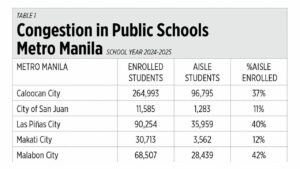Education Secretary Sonny Angara recently stated that given the current budget and the growing classroom shortage, it could take up to 30 years to fully address public school congestion.
Given this, the Cristina Research Foundation, a public policy research and advocacy organization (full disclosure: We are the Chairman of Cristina Research), decided to conduct a study on the congestion in our Elementary and High School public schools.
The initial conclusion is that the 30-year period is optimistic. The current backlog is 165,000 classrooms and yet less than 1,000 new classrooms were constructed in 2024.
To better understand the congestion problem, Cristina Research created three maps to visualize congestion on three levels: 1.) regional, 2.) division-wide, and, 3.) city level. The data generated displayed enrollment and average pupil-classroom-ratio (PCR) within each sample region.
Cristina Research then decided to focus on congestion in Metro Manila where the congestion is critical as shown in Table 1.
Note that while Metro Manila students account for only 9% of enrolled students in public schools, they account for 21.8% of the congestion in public schools. This is understandable given that the main bottleneck of the government school building program is the lack of properties in which to construct classrooms and Metro Manila is, of course, crowded.
Given this information Cristina Research approached Pasig Mayor Vico Sotto asking for an opportunity to present its findings on his city’s public schools. He invited Cristina Research to present its findings to the Pasig City Local School Board (LSB) on June 23.
A summary of the presentation is shown in Table 2. As shown, of the 142,463 students enrolled in the Pasig City public schools in School Year 2025-2026, 28,295 are “aisle” students. “Aisle” students are students enrolled in the Second and Third shifts of the school day or are in classes that are above the optimum size of 45 students. Of the 44 public schools in Pasig City, 17 are on double shifts. Included in the presentation was the annual cost of school vouchers* if all the 28,295 aisle students were issued vouchers which would allow them to attend private schools.
The proposed voucher program was positively received by Mr. Sotto, who asked about the absorptive capacity of the Pasig City private schools. This would help determine the feasibility and potential impact of the proposed approach.
In response, on July 9, Cristina Research, with the full support of Dr. Ellaine Praxidio, the president of the Pasig Alliance of Private School Administrators, Inc. (PAPRISA) met with the PAPRISA board to conduct a survey among the group’s members on available slots to absorb the aisle students of the Pasig City public schools.
PAPRISA agreed and the survey was conducted. On July 29, Cristina Research presented the results of the survey to the Pasig City School Board.
Data was collected from 71 of 73 private schools and consisted of: 1.) tuition fees per level, 2.) available slots per level, and 3.) overall capacity per level. More importantly, the survey showed that private schools in Pasig City have enough available seats to accommodate only 17,116 of the 28,295 aisle students.
We consider this a promising start, as we are confident that once a voucher program is launched by the Pasig City government, the private schools can readily increase the available seats, unburdened as they are by government bureaucratic red tape.
At that same meeting, we conveyed the offer of two organizations to assist the city in designing and implementing the school voucher program.
The first is the Private Education Assistance Committee (PEAC), headed by Executive Director Doris Ferrer. PEAC designed and administers the national school voucher system for Senior High School students. Dr. Ferrer offered PEAC’s expertise to assist in the local voucher program.
The other organization is the Universal Storefront Services Corp. (USSC) headed by President Eckie Gonzales. USSC handled the National Registry System for Farmers and Fishers (RFFA) of the Department of Agriculture which transferred cash to the accounts of 2.3 million beneficiaries. USSC also handled the Malabon “Ahon Card” program which handled the ayuda (assistance) program for 87,000 beneficiaries. Mr. Gonzales also offered their expertise.
As Mr. Sotto and the Pasig City School Board work out the details of a voucher program in time for implementation in the coming school year (2026-2027), Cristina Research has approached several other Metro Manila mayors who have both the interest and the financial resources to adopt a similar plan.
What about those mayors who have the interest but not the financial resources?
Senator Sherwin Gatchalian and Congressman Roman Romulo have filed bills in Congress seeking to increase the budget of our present voucher system and, more importantly, to extend the coverage from Senior High School to Junior High School, Elementary, and Kindergarten.
The plan would be that as local government units with financial resources launch their local voucher systems, the national vouchers legislated by Messrs. Gatchalian and Romulo could then be directed to those local government units who do not have the financial resources to launch their own voucher system.
Given this emerging partnership between Congress, PEAC, local government executives, the associations of private schools like the PAPRISA, and private companies like USSC, there is reason to hope that the congestion in our public schools can be solved, not in 30 years but in three years.
* A system where public school students are issued vouchers which allow them to attend a private school which can, in turn, redeem the vouchers from the government.
Dr. Victor S. Limlingan is a retired professor of AIM and is a fellow of the Foundation for Economic Freedom. He is presently chairman of Cristina Research Foundation, a public policy adviser, and Regina Capital Development Corp., a member of the Philippine Stock Exchange.
